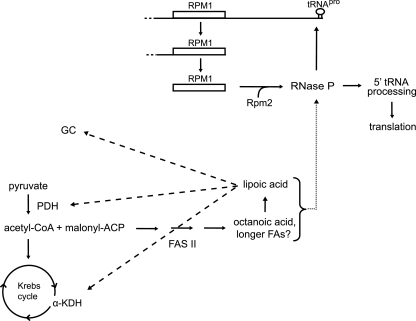FIG. 9.
Positive feedback loops governing fatty acid-lipoic acid biosynthesis and RNase P activity. The intersection of the FAS II pathway and RNase P activity in yeast mitochondria is depicted as a cartoon. In the FAS II pathway, acetyl-CoA (or acetyl-acyl carrier protein [ACP]) and malonyl-ACP are condensed on ACP, and the carbon chain is elongated in several iterative steps to produce octanoic acid (21) (Fig. 3). Other enzymes convert octanoic acid to lipoic acid (50) and attach the cofactor to target proteins (28). Lipoic acid is required for pyruvate dehydrogenase activity, creating one positive feedback loop. Fatty acid and/or lipoic acid is required for efficient RNase P activity. The second positive feedback loop is created because RNase P activity is required for the maturation of its own RNA subunit, RPM1, via an endonucleolytic cleavage of tRNAPro from the pre-RPM1-pro precursor RNA. The dashed arrows represent the requirement of lipoic acid for PDH, α-KDH, and GC enzymatic activity. The dotted arrow (at right) represents the requirement of a product of the FAS II pathway for RNase P activity or assembly.

